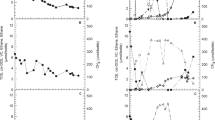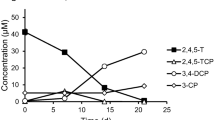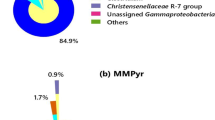Abstract
The anaerobic degradation ofp-cresol was studied with one sediment source under three reducing conditions—denitrifying, sulfidogenic, and methanogenic. Loss ofp-cresol (1 mM) in all the anaerobic systems took initially 3 to 4 weeks. In acclimated culturesp-cresol was degraded in less than a week.p-Cresol was completely metabolized under denitrifying, sulfidogenic, and methanogenic conditions, with formation of nitrogen gas, loss of sulfate, and formation of methane and carbon dioxide, respectively.p-Cresol metabolism proceeded throughp-hydroxybenzal-dehyde andp-hydroxybenzoate under denitrifying and methanogenic conditions. These compounds were rapidly degraded in cultures acclimated top-cresol under all three reducing conditions. These results suggest that the initial pathway ofp-cresol degradation is the same under denitryfying, sulfidogenic, and methanogenic conditions and proceeds via oxidation of the methyl substituent top-hydroxybenzaldehyde andp-hydroxybenzoate. The initial rate ofp-hydroxybenzaldehyde degradation was high in both the unacclimated cultures and in the cultures acclimated top-cresol, suggesting that this step is nonspecific. Benzoate was additionally detected as a metabolite followingp-hydroxybenzoate in the methanogenic cultures, but not in the denitrifying or sulfidogenic cultures. The degradation pathway therefore may diverge afterp-hydroxybenzoate formation depending on which electron acceptor is available.
Similar content being viewed by others
References
Bak F, Widdel F (1986) Anaerobic degradation of phenol and phenol derivatives byDesulfobacterium phenolium sp. nov, Arch Microbiol 146:177–180
Bakker G (1977) Anaerobic degradation of aromatic compounds in the presence of nitrate. FEMS Letters 1:103–108
Bossert ID, Young LY (1986) Anaerobic oxidation ofp-cresol by a denitrifying bacterium. Appl Environ Microbiol 52:1117–1122
Bossert ID, Rivera MD, Young LY (1986)p-Cresol biodegradation under denitrifying conditions: isolation of a bacterial coculture, FEMS Microbiol Ecol 38:313–319
Bossert ID, Whited G, Gibson DT, Young LY (1989) Anaerobic oxidation ofp-cresol mediated by a partially purified methylhydroxylase from a denitrifying bacterium J Bacteriol 171:2956–2962
Dagley S, Patel MD (1957) Oxidation ofp-cresol and related compounds by aPseudomonas. Biochem J 66:227–233
Ehrlich GG, Godsy EM, Goerlitz DF, Hult MF (1983) Microbial, ecology of a creosote-contaminated aquifer at St. Louis Park, Minnesota. Dev Ind Microbiol 24:235–245
Evans WC (1977) Biochemistry of the bacterial catabolism of aromatic compounds in anaerobic environments. Nature (Lond) 270:17–22
Fedorak PM, Hrudey SE (1984) The effects of phenol and some alkyl phenolics on batch anaerobic methanogenesis. Water Res 18:361–367
Genthner BR Sharak, Price WA II, Pritchard PH (1989) Characterization of anaerobic dechlorinating consortia derived from aquatic sediments. Appl Environ Microbiol 55:1472–1476
Genthner BR Sharak, Townsend GT, Chapman PJ (1989) Anaerobic transformation of phenol to benzoate viapara-carboxylation: use of fluorinated analogues to elucidate the mechanism of transformation. Biochem Biophys Res Comm 162:945–951
Glöckler R, Tschech A, Fuchs G (1989) Reductive dehydroxylation of 4-hydroxybenzoyl-CoA to benzoyl-CoA in a denitrifying, phenol-degradingPseudomonas species. FEBS Letters 251:237–240
Godsy EM, Goerlitz DF, Ehrlich GG (1983) Methanogenesis of phenolic compounds by a bacterial consortium from a contaminated aquifer in St. Louis Park, Minnesota. Bull Environ Contam Toxicol 30:261–268
Goerlitz DF, Troutman DE, Godsy EM, Franks BJ (1985) Migration of wood-preserving chemicals in contaminated groundwater in a sand aquifer at Pensacola, Florida. Environ Sci Technol 19:955–961
Harwood CS, Gibson J (1988) Anaerobic and aerobic metabolism of diverse aromatic compounds by the photosynthetic bacteriumRhodopseudomonas palustris. Appl Environ Microbiol 54:712–717
Healy JB Jr, Young LY (1979) Anaerobic biodegradation of eleven aromatic compounds to methane. Appl Environ Microbiol 38:84–89
Hopper DJ (1978) Incorporation of [18O] water in the formation ofp-hydroxybenzyl alcohol by thep-cresol methylhydroxylase fromPseudomonas putida. Biochem J 175:345–347
Hopper DJ, Taylor DG (1975) Pathways for degradation ofm-cresol andp-cresol byPseudomonas putida. J Bacteriol 122:1–6
Howarth RW (1978) A rapid and precise method for determining sulfate in seawater, estuarine waters, and sediment pore waters. Limnol Oceanogr 23:1069–1072
Humenick MJ, Britton LN, Mattox CF (1982) Natural restoration of ground water in UCG. In Situ 6:107–125
Knoll G, Winter J (1987) Anaerobic degradation of phenol in sewage sludge. Benzoate formation from phenol and CO2 in the presence of hydrogen. Appl Microbiol Biotechnol 25:384–391
Knoll G, Winter J (1989) Degradation of phenol via carboxylation to benzoate by a defined, obligate syntrophic consortium of anaerobic bacteria. Appl Microbiol Biotechnol 30:318–324
Kobayashi T, Hashinaga T, Mikami E, Suzuki T (1989) Methanogenic degradation of phenol and benzoate in acclimated sludges. Wat Sci Tech 21:55–65
Kuhn EP, Suflita JM, Rivera MD, Young LY (1989) Influence of alternate electron acceptors on the metabolic fate of hydroxybenzoate isomers in anoxic aquifer slurries. Appl Environ Microbiol 55:590–598
Lovley DR, Baedecker MJ, Lonergan DJ, Cozzarelli IM, Phillips EJP, Siegel DI (1989) Oxidation of aromatic contaminants coupled to microbial iron reduction. Nature 339:297–300
Roberts DS, Fedorak PM, Hrudey SE (1990) CO2 incorporation and 4-hydroxy-2-methylbenzoic acid formation during anaerobic metabolism ofm-cresol by a methanogenic consortion. Appl Environ Microbiol 56:472–478
Sawhney BL, Kozloski RP (1984) Organic pollutants in leachates from landfill sites. J Environ Qual 13:349–352
Smolenski WJ, Suflita JM (1987) Biodegradation of cresol isomers in anoxic aquifers. Appl Environ Microbiol 53:710–716
Suflita JM, Liang L, Saxena A (1989) The anaerobic biodegradation ofo-, m-andp-cresol by sulfate-reducing bacterial enrichment cultures obtained from a shallow anoxic aquifer. J Ind Microbiol 4:255–266
Stuermer DH, Ng DJ, Morris CJ (1982) Organic contaminants in groundwater near an underground coal gasification site in northeastern Wyoming. Environ Sci Technol 16:582–587
Tschech A, Fuchs G (1987) Anaerobic degradation of phenol by pure cultures of newly isolated denitrifying pseudomonads. Arch Microbiol 148:213–217
Tschech A, Fuchs G (1989) Anaerobic degradation of phenol via carboxylation to 4-hydroxy-benzoate:in vitro study of isotope exchange between14CO2 and 4-hydroxybenzoate. Arch Microbiol 152:594–599
Tschech A, Schink B (1986) Fermentative degradation of monohydroxybenzoates by defined syntrophic cocultures. Arch Microbiol 145:396–402
Young LY, Rivera MD (1985) Methanogenic degradation of four phenolic compounds. Water Res 19:1325–1332
Zhang X, Morgan TV, Wiegel J (1990) Conversion of13C-1 phenol to13C-4 benzoate, an intermediate step in the anaerobic degradation of chlorophenols. FEMS Microbiol Lett 67:63–66
Author information
Authors and Affiliations
Rights and permissions
About this article
Cite this article
Häggblom, M.M., Rivera, M.D., Bossert, I.D. et al. Anaerobic biodegradation ofPara-cresol under three reducing conditions. Microb Ecol 20, 141–150 (1990). https://doi.org/10.1007/BF02543873
Issue Date:
DOI: https://doi.org/10.1007/BF02543873




